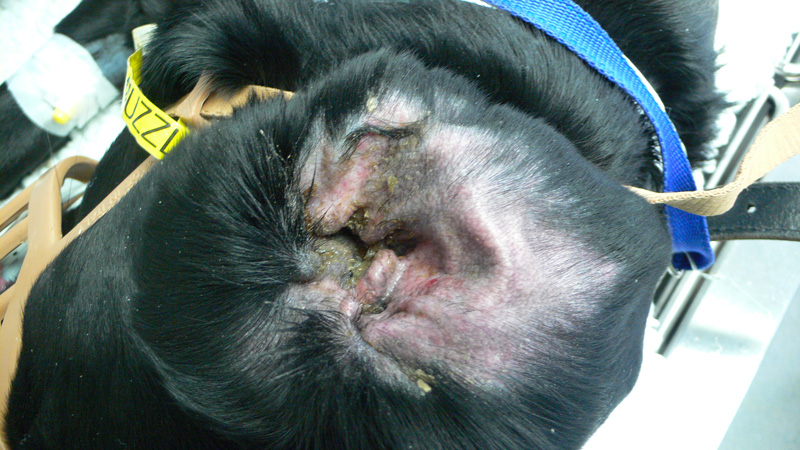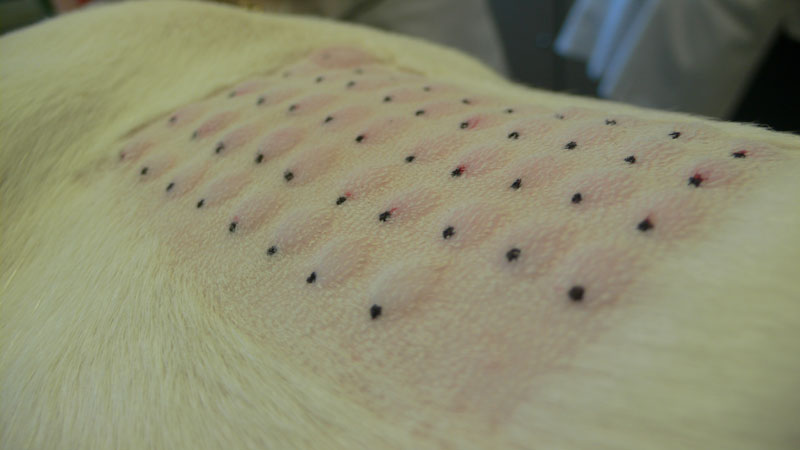Why Should I Bring my Pet to Willows for Atopic Dermatitis?
Willows is one of Europe’s leading small animal referral centres. Our state-of-the-art hospital is led by internationally renowned Specialists who are committed to providing the highest standards of veterinary care.
Willows Skin and Ear Clinic is led by Drs Richard Harvey and Tania Nunes Rodrigues, European Specialists in Veterinary Dermatology who have has extensive experience of managing cases of atopic dermatitis. Onsite access to intradermal allergy testing allows full investigation and treatment of patients suffering from this condition.
What is Atopic Dermatitis?
Allergic diseases result when the body’s immune system, reacts to harmless substances that the majority of the population tolerate without problems.
Atopy is an allergic disease that can be characterised by itching and ear disease. The itch may be summer seasonal, however, it is usually recurring, although it may increase and decrease in severity. The itch is moderate, and most dogs do not scratch when exercising or when their attention is diverted.
Typically, dogs who suffer from atopic dermatitis are young adults and show some, or all, of the following signs:
- Sneezing, conjunctivitis, and facial itch
- Usually, bilateral (both sides), recurrent or chronic ear disease (in some dogs, otitis is the only sign of atopy)
- Foot licking or chewing
- Scratching or licking armpits, tummy, and groins
The equivalent disease in humans is known as atopic eczema, and this is relatively common in the Western World. Atopic dermatitis is one of the most common allergic skin diseases in dogs and cats.
What Causes Atopic Dermatitis?
The underlying cause of atopy is complex and is not yet fully understood. Affected dogs have increased numbers of bacteria on the skin surface, skin barrier defects and an inappropriate immune response. This results in sensitisation and an allergic response to environmental allergens such as house dust mites and grass pollens.
Atopy is, at least in part, a hereditary disease and there are certain breeds of dog are predisposed:
- West Highland White Terriers
- Bull terriers and French bulldogs
- Labrador retrievers
- Chinese Shar pei
- Cocker and Springer Spaniels

What are the Signs of Atopic Dermatitis?
Atopic dermatitis is hereditary, and there are certain breeds of dog such as West Highland White Terriers, Labradors, Chinese Shar peis and Springer Spaniels that are more prone to developing the disease. Skin disease usually presents with itching, and commonly affects the face, ears, feet, armpits and stomach. Recurrent ear infections are also very common, and some dogs with atopic dermatitis only have ear disease (Figure 1). The inflammation within the skin causes redness, rashes, increased pigmentation (darkening of the skin) and recurrent infections. Skin disease usually develops between the ages of six months and three years.
In some affected animals, the allergic reaction can also cause eye problems including conjunctivitis or respiratory diseases such as sneezing. In other respects, affected animals remain healthy.


What Treatments are Available for Atopic Dermatitis?
Treatments for atopic dermatitis aim to reduce the overactive immune system and also improve the barrier of the skin to prevent further penetration of the allergens. There are many different treatments and combinations of treatments, all with their own advantages and disadvantages, and their use can be discussed in detail during your pet’s consultation and may include.
- Treatments to improve skin barrier function,
- Malaseb shampoo to control secondary infection (rather than antibiotic tablets)
- Ear disease may require long-term management as the underlying allergic cause means it will not go away, which can be a cause of frustration
- An itch must be suppressed:
- Low-dose prednisolone can be used to control approx. 100% of cases
- Lokivetmab (Cytopoint) injections every 4-6 weeks can control approx. 70% cases
- Oclacitinib (Apoquel) tablets, can control approx. 70% of cases
- Ciclosporin (Atopica) capsules, can control approx. 65% of cases
- Allergic responses can be diverted or suppressed with blocking injections. This is known as allergen-specific immunotherapy. The offending allergens must be identified, typically by intradermal skin testing, although an ELISA blood test can sometimes be used and can control approx. 65% of cases.

How is Atopic Dermatitis Diagnosed?
Atopic dermatitis can be diagnosed following a thorough evaluation of the patient’s history, assessment of the pet’s clinical signs and elimination of other similar diseases. Unfortunately, there is no single diagnostic test that definitively diagnoses the condition.
What Can I Expect if my Pet is Treated for Atopic Dermatitis?
In the vast majority of cases, atopic dermatitis can be controlled very well, and pets can lead a normal and healthy life. As atopic dermatitis is a lifelong condition, periodic re-examinations with a Specialist Dermatologist throughout the animal’s life are recommended to maintain close control over the disease and its clinical signs.
To save this page as a PDF, click the button and make sure “Save as PDF” is selected.
Skin and Ear Clinic
Find out more
To assist owners whose pets have skin and ear conditions, we have put together a range of information pages to talk you through some of the more common dermatology conditions seen by our Specialist team.

